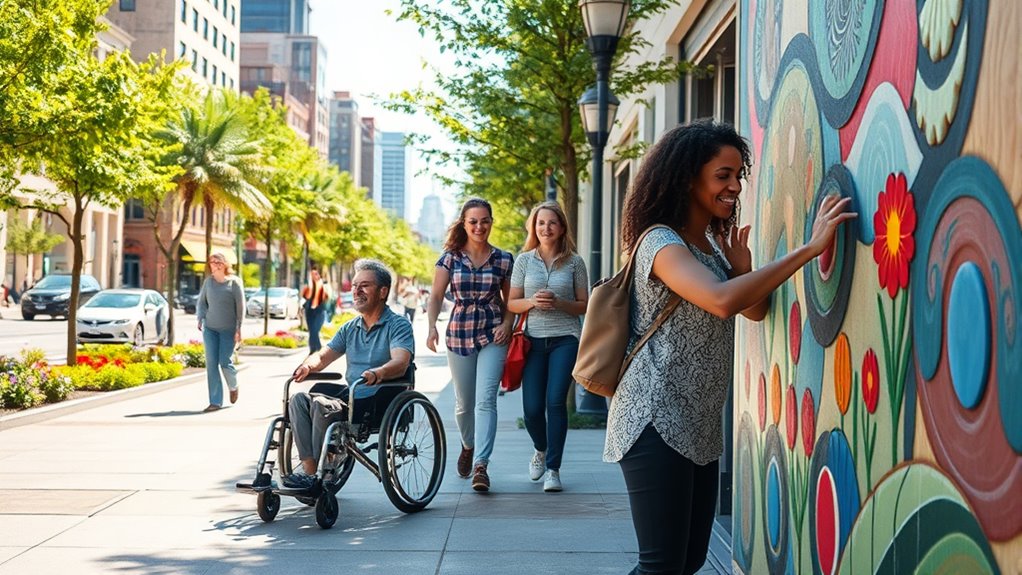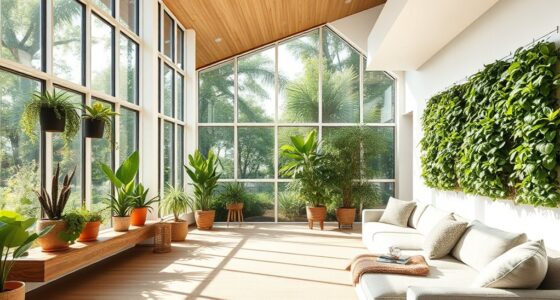Accessible aesthetics mean designing spaces, art, fashion, and experiences that are welcoming and functional for everyone, regardless of abilities or sensory sensitivities. By embracing inclusive principles, using innovative materials, and employing technology, you can create beauty that breaks barriers and celebrates diversity. Think adaptable environments, textured surfaces, and sensory-friendly features that enhance comfort and engagement. Keep exploring, and you’ll discover how to make beauty truly for all, without boundaries.
Key Takeaways
- Inclusive design integrates sensory and ergonomic features to create spaces that are comfortable and accessible for all abilities.
- Cultural diversity and authentic representation in art and fashion promote broader, inclusive definitions of beauty.
- Innovative materials and responsive surfaces enhance both aesthetic appeal and sensory accessibility.
- Spaces designed with adjustable lighting, textures, and clear navigation support universal engagement.
- Technology like assistive apps and virtual try-ons personalize experiences, fostering confidence and independence for everyone.
The Principles Behind Inclusive Design

What makes a design truly inclusive? It’s about seamlessly blending sensory integration and adaptive ergonomics to meet diverse needs. Sensory integration guarantees that spaces and objects cater to various sensory sensitivities, providing comfort without overwhelming. Adaptive ergonomics focuses on creating adaptable environments that suit different physical abilities, promoting ease of use for everyone. When these principles are combined, design becomes more flexible and responsive, breaking down barriers that exclude certain individuals. For example, adjustable lighting and tactile feedback can enhance accessibility. Additionally, incorporating natural materials can support sensory comfort and promote a welcoming atmosphere. Inclusive design isn’t just about compliance; it’s about anticipating and honoring diverse experiences. By prioritizing sensory integration and adaptive ergonomics, you create environments that are welcoming, functional, and truly accessible for all users.
Celebrating Diversity in Visual Arts and Fashion
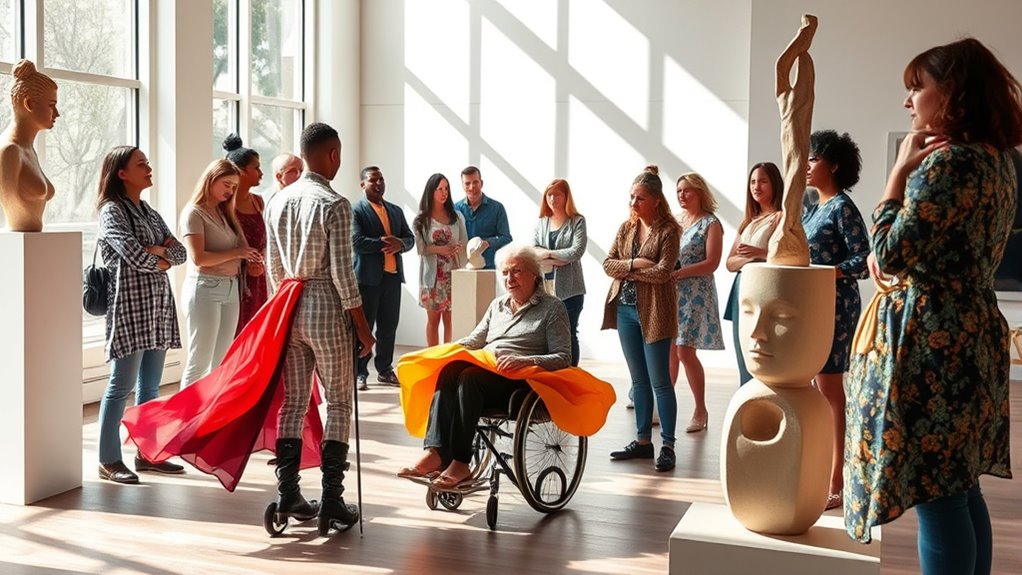
Celebrating diversity in visual arts and fashion enriches creative expression by showcasing a wide range of cultural backgrounds, identities, and perspectives. Your appreciation for cultural representation highlights the importance of authentic storytelling through art and design. This diversity inspires new ideas and broadens understanding. To recognize this, consider these key aspects:
- Incorporate authentic cultural symbols and motifs into artwork and clothing.
- Support artists and designers from various backgrounds to promote inclusive artistic expression.
- Highlight stories behind diverse cultural influences to deepen audience engagement.
- Use fashion as a platform to challenge stereotypes and celebrate unique identities.
Additionally, understanding the cultural significance behind certain symbols can foster greater respect and appreciation for the diverse stories being told.
Innovative Materials and Techniques for Accessibility

You can improve accessibility by exploring adaptive materials that respond to user needs, like flexible textiles or tactile surfaces. Using inclusive design techniques guarantees spaces and products accommodate diverse abilities seamlessly. Embracing these innovations helps create environments that are both functional and aesthetically appealing for everyone. For instance, integrating waterproof ebike conversion kits into urban mobility options ensures reliability across various weather conditions, enhancing overall accessibility and user experience.
Adaptive Material Innovations
Innovative materials are transforming how we approach accessibility by offering adaptable and responsive solutions. These advancements enable environments to cater to diverse sensory needs and promote sensory integration seamlessly. Adaptive textiles, for example, adjust their texture or temperature based on user interaction, creating more inclusive spaces. Here are four key innovations:
- Smart fabrics that respond to touch and temperature changes
- Sensor-embedded materials that detect movement or pressure
- Thermochromic surfaces altering color with temperature shifts
- Lightweight, durable composites that support mobility aids
Additionally, the integration of responsive surfaces allows for environments that adapt in real-time to user interactions, enhancing both functionality and aesthetic appeal. These materials improve both function and aesthetics, making spaces more welcoming for everyone. By integrating adaptive textiles and responsive surfaces, you create environments that truly accommodate varied sensory experiences, ensuring accessibility without sacrificing beauty.
Inclusive Design Techniques
Inclusive design techniques harness innovative materials and thoughtful strategies to create spaces that are accessible to all users. By emphasizing high color contrast, you guarantee visual clarity for those with visual impairments, making signage and pathways easier to distinguish. Tactile feedback plays a vital role, allowing individuals to interact with surfaces through touch, enhancing navigation and safety. You can incorporate textured flooring, raised symbols, or braille labels to provide sensory cues that guide and inform. These methods help bridge gaps for users with different needs, promoting independence and comfort. Additionally, understanding compatible headphone jacks and how to troubleshoot or repair audio devices ensures accessible audio solutions for everyone. By integrating these innovative materials and strategies, you make environments welcoming and functional, affirming everyone can experience beauty without barriers. Your commitment to inclusive design elevates aesthetics while prioritizing accessibility.
Designing Spaces That Welcome Everyone

How can designers create spaces that truly welcome everyone? Focus on sensory integration and ergonomic comfort to guarantee inclusivity. Start by considering lighting and textures that cater to different sensory needs, avoiding overstimulation. Incorporate adjustable furniture that supports ergonomic comfort, making spaces accessible for all body types. Use clear signage with tactile and visual cues so everyone can navigate easily. Finally, design open layouts that promote easy movement and interaction. Additionally, integrating family-friendly attractions and amenities can enhance the overall accessibility and enjoyment of the space for visitors of all ages and abilities.
The Role of Technology in Enhancing Accessibility

Technology plays a crucial role in making spaces more accessible by providing solutions that adapt to diverse needs. Virtual try-ons allow you to explore clothing and accessories virtually, removing barriers for those who can’t visit stores easily. Assistive apps help you navigate environments, communicate, or perform daily tasks more independently. These tools empower you to engage with beauty and fashion without limitations. For example, virtual try-ons give you confidence in your choices, while assistive apps enhance your overall experience. As technology advances, its ability to personalize and simplify accessibility increases, creating more inclusive spaces. Cookie preferences can be managed to ensure a tailored browsing experience, respecting your privacy choices. By integrating these innovations into design, you’re offered greater freedom to express your unique style and beauty, fostering a truly barrier-free environment.
Inspiring Examples of Barrier-Free Beauty

Innovative design and creative initiatives are transforming beauty standards by showcasing barrier-free aesthetics that celebrate diversity. These inspiring examples emphasize sensory aesthetics and tactile experiences, making beauty inclusive for all. Incorporating accessible design principles ensures that environments and art are welcoming and usable for everyone. Here are four standout examples:
- Public sculptures with textured surfaces invite touch, engaging tactile senses.
- Clothing lines featuring varied fabrics and accessible designs promote sensory-rich experiences.
- Art installations designed for both visual and tactile exploration foster inclusivity.
- Architectural features like textured walls and ramps enhance sensory accessibility, blending form and function seamlessly.
These initiatives prove beauty isn’t just seen but felt and experienced through touch and sensory engagement, breaking barriers and inspiring a more inclusive understanding of aesthetics.
Challenges and Opportunities in Creating Inclusive Aesthetics
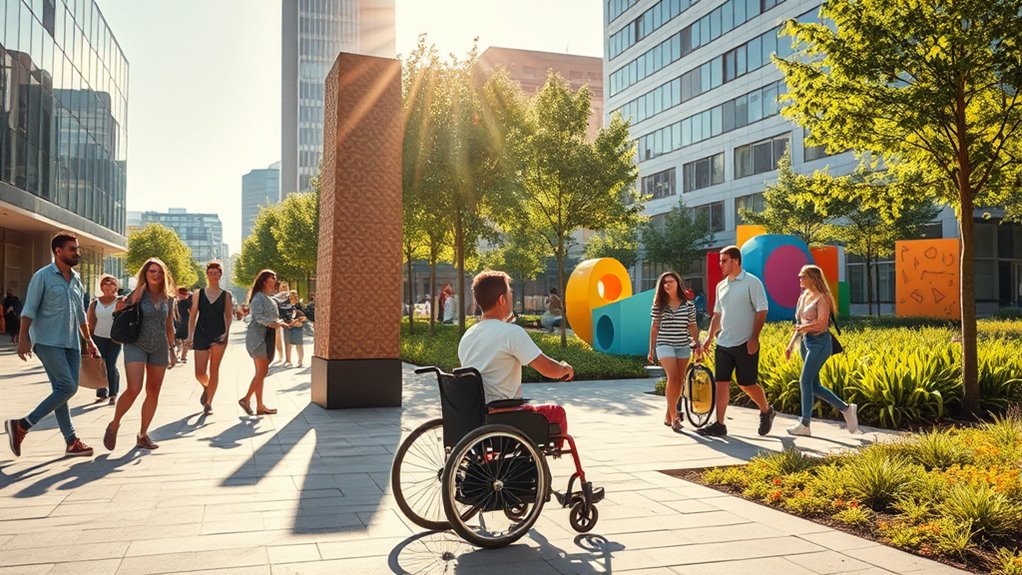
Designing for diverse needs can be challenging, but it opens the door to more meaningful connections with your audience. Overcoming accessibility barriers requires innovation and a willingness to rethink traditional aesthetics. By embracing universal appeal, you have the opportunity to create beauty that truly includes everyone. Incorporating inclusive nail styles ensures that beauty standards are adaptable to various preferences and needs, fostering a more welcoming environment for all.
Design for Diverse Needs
Creating inclusive aesthetics presents both significant challenges and valuable opportunities, especially when considering the diverse needs of all users. To design effectively, you must focus on sensory integration—balancing visual, tactile, and auditory elements to accommodate different perceptions. Recognize cultural symbolism, ensuring designs respect diverse backgrounds and avoid unintended misinterpretations. Incorporating Forsale 100 can also help in sourcing diverse materials and resources to support inclusive design. Consider these key aspects:
- Incorporate varied textures and contrasts for sensory-sensitive users
- Use culturally meaningful symbols thoughtfully and inclusively
- Balance visual appeal with accessibility features
- Engage diverse communities to understand their unique needs
Overcoming Accessibility Barriers
Addressing accessibility barriers in aesthetic design presents both complex challenges and valuable opportunities to foster inclusivity. You can enhance sensory experiences by integrating sensory enhancement techniques, making aesthetics more engaging for everyone. For example, using contrasting textures, sounds, or tactile elements allows people with different sensory needs to appreciate the design fully. Aesthetic customization offers another avenue to overcome barriers, enabling users to modify visuals or features to suit their preferences and abilities. While technical and budget constraints can be obstacles, embracing flexible, adaptable designs encourages broader participation. By actively seeking innovative solutions, you open pathways for diverse audiences to experience beauty without barriers, transforming aesthetic spaces into inclusive environments where everyone feels seen and valued.
Embracing Universal Appeal
Embracing universal appeal in aesthetic design offers both significant challenges and rewarding opportunities to foster inclusivity. Achieving true aesthetic inclusivity means designing visuals that resonate across diverse cultures, abilities, and preferences. To succeed, consider these key points:
- Understand diverse cultural symbols and meanings.
- Prioritize accessibility features that enhance visual and sensory engagement.
- Balance boldness with subtlety to appeal broadly without alienating any group.
- Test designs with varied audiences to gather inclusive feedback.
How Individuals and Communities Can Promote Beauty for All
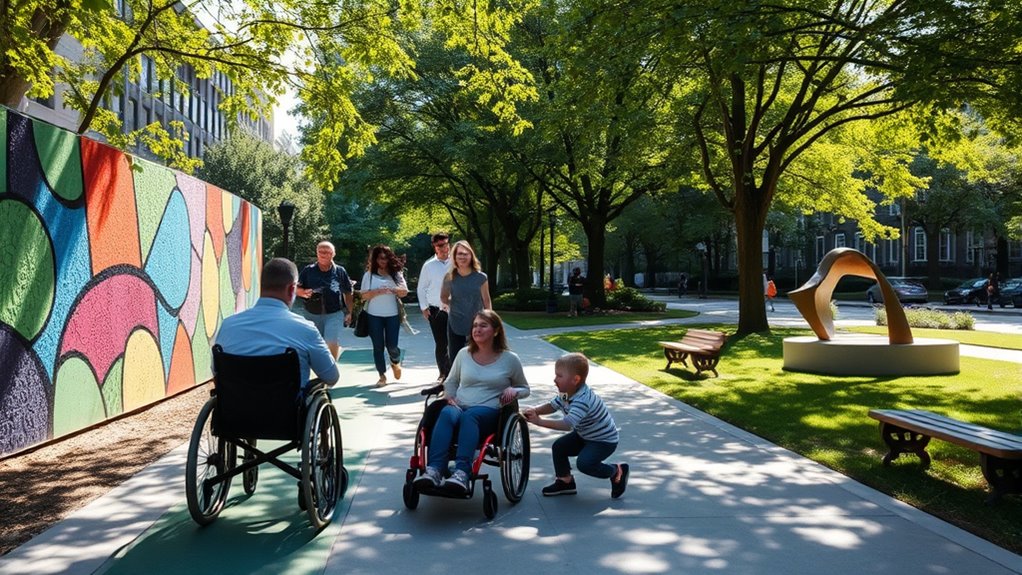
When individuals and communities actively prioritize inclusivity, they can transform perceptions of beauty to reflect diversity and accessibility. Engaging with others fosters understanding and celebrates different cultural representations. Your efforts in community engagement create spaces where everyone feels valued and seen. To inspire change, consider this table:
| Action | Impact |
|---|---|
| Support diverse art projects | Promotes cultural representation and visibility |
| Organize inclusive events | Builds community and broadens beauty standards |
| Amplify marginalized voices | Challenges stereotypes and encourages acceptance |
Frequently Asked Questions
How Can Small Brands Implement Accessible Design Principles Effectively?
You can implement accessible design principles by focusing on inclusive branding and user-centric design. Start by understanding the diverse needs of your audience, ensuring your visuals, language, and interfaces cater to everyone. Use high-contrast colors, clear fonts, and simple navigation. Test your designs with real users, gather feedback, and make improvements. This approach shows your commitment to accessibility and helps create a welcoming brand experience for all.
What Funding Options Are Available for Inclusive Art and Fashion Projects?
Sure, funding is everywhere—if you know where to look. You can tap into grant opportunities specifically for inclusive art and fashion projects, or explore sponsorship programs that champion diversity. Ironically, the hardest part is often just finding these resources amidst a sea of options. Your best bet is to research organizations dedicated to accessibility and inclusion, then craft compelling proposals that highlight how your project fosters beauty without barriers.
How Do Cultural Differences Influence Perceptions of Beauty and Accessibility?
Cultural differences shape how you perceive beauty and accessibility by influencing norms and aesthetic diversity. You might see beauty through traditional standards or embrace diverse forms that challenge those norms. These cultural perspectives affect what you consider accessible, encouraging you to appreciate different expressions of beauty. By recognizing these influences, you can foster inclusivity, ensuring that aesthetic diversity and accessibility are valued across diverse cultural contexts.
What Role Do Policymakers Play in Promoting Barrier-Free Aesthetics?
Policymakers are the architects shaping a landscape where beauty is for everyone. By engaging in policy advocacy and crafting legislative frameworks, you guarantee designs break down barriers, making aesthetics accessible for all. Your role is crucial—setting standards, funding inclusive projects, and championing diversity—so that society’s visual environment becomes a tapestry woven with threads of equality. Together, you turn the vision of barrier-free beauty into a tangible reality.
How Can Urban Planners Incorporate Accessibility Into Public Art Installations?
You can incorporate accessibility into public art installations by applying universal design principles, ensuring everyone can enjoy and engage with the art. Use inclusive signage that clearly communicates meaning for all visitors, including those with visual or cognitive impairments. Position installations thoughtfully to accommodate diverse mobility needs, and select tactile or audio features where appropriate. Your goal is to create art that’s welcoming, functional, and accessible to everyone, regardless of ability.
Conclusion
By embracing inclusive design, you open doors to a world where beauty knows no barriers. Every color, shape, and space becomes a celebration of diversity, inviting everyone to feel seen and valued. When you champion accessibility, you transform not just environments but perceptions—breaking down walls with kindness and innovation. Remember, true beauty flows where barriers fall, and in your efforts, you hold the power to create a future where everyone’s unique light shines brightly.
